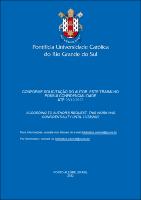| Share record |


|
Please use this identifier to cite or link to this item:
https://tede2.pucrs.br/tede2/handle/tede/10328| Document type: | Tese |
| Title: | Avaliação tomográfica quantitativa em doença pulmonar obstrutiva e restritiva crônica pelo índice do pulmão normal |
| Author: | Barros, Marcelo Cardoso  |
| Advisor: | Hochhegger, Bruno |
| First advisor-co: | Chatkin, Jose Miguel |
| Abstract (native): | Objetivo: Avaliar se o índice pulmonar normal (IPN) obtido através da análise por tomografia computadorizada quantitativa (TCQ) pode ser usado para predizer mortalidade, assim como os testes funcionais pulmonares (TFPs), em pacientes com doença pulmonar obstrutiva crônica (DPOC) e doença intersticial pulmonar (DIP). Materiais e métodos: Indivíduos normais (n = 20), pacientes com DPOC (n = 172) e DIP (n = 114) que realizaram TFPs e TCQ foram inscritos retrospectivamente neste estudo. As medidas de TCQ incluíram o IPN, definido como o percentual de volume pulmonar no intervalo de -950 a -700 unidades Hounsfield (UH) em relação ao volume pulmonar total (intervalo de -1024 a -250 UH), áreas de alta atenuação pulmonar (AAAP) (intervalo de –700 a -250 UH, %), índice de enfisema (ponto de corte < – 950 UH), Skewness, Kurtosis e densidade pulmonar média. Os coeficientes de correlação entre as medições da TCQ e os resultados dos TFPs em todos os indivíduos foram calculados. Análises de sobrevida por metodologia univariada e multivariada foram realizadas para avaliar predição de mortalidade por doença, assim como gráficos de sobrevivência de Kaplan-Meier. Resultados: O ‘‘p de Pearson’’ mostrou que o IPN se correlacionou moderadamente com o volume expiratório forçado no primeiro segundo (VEF1) em indivíduos com DPOC (r = 0,490; p < 0,001), e a capacidade vital forçada (CVF) em indivíduos com DIP (r = 0,452; p < 0,001). A análise multivariada revelou que o IPN < 70 % foi um preditor independente de mortalidade em indivíduos com DPOC (razão de risco (RR) = 3,14; p = 0,034) e DIP (RR = 2,72; p = 0,033). O IPN está ligado ao grau de perda do VEF1 e CVF. No grupo DPOC, a mortalidade em 5 anos para pacientes com IPN < 70 % versus IPN > 70 % foi de, respectivamente, 27,8 % e 13,5 % (p = 0,002). No grupo DIP, a mortalidade em 5 anos para pacientes com IPN < 70 % versus IPN > 70 % foi de, respectivamente, 40,7 % e 29,9 % (p = 0,05). Conclusão: O IPN, na análise por TCQ, pode ser usado para predizer mortalidade em indivíduos com DPOC e DIP. |
| Abstract (english): | Purpose: Our objective was to evaluate whether the normal lung index (NLI) from quantitative computed tomography (QCT) analysis can be used to predict mortality as well as pulmonary functional tests (PFTs) in patients with chronic obstructive pulmonary disease (COPD) and interstitial lung disease (ILD). Materials and Methods: Normal subjects (n = 20) and patients with COPD (n = 172) and ILD (n = 114) who underwent PFTs and chest CT were enrolled retrospectively in this study. QCT measures included the NLI, defined as the ratio of lung with attenuation between –950 to –700 Hounsfield units (HU) over total lung volume (-1024 to -250HU, mL), high-attenuation areas (–700 to –250 HU, %), emphysema index (< –950 HU), Skewness, Kurtosis, and mean lung attenuation. Coefficients of correlation between the QCT measurements and PFT results in all subjects were calculated. Univariate and multivariate survival analyses were performed to assess mortality prediction by disease, as well Kaplan-Meier curves. Results: Pearson’s correlation analysis showed that the NLI correlated moderately with the forced expiratory volume in 1 s in subjects with COPD (r = 0.490, p < 0.001) and the forced vital capacity in subjects with ILD (r = 0.452, p < 0.001). Multivariate analysis revealed that the NLI of < 70 % was a significant independent predictor of mortality in subjects with COPD (HR = 3.14, p = 0.034) and ILD (HR = 2.72, p = 0.033). In the COPD group, the 5-year mortality for patients with NLI < 70% versus NLI > 70 % was, respectively, 27.8 % and 13.5 % (p = 0.002). In the ILD group, the 5-year mortality for patients with NLI < 70 % versus NLI > 70 % was, respectively, 40.7 % and 29.9 % (p = 0.05). Conclusion: QCT analysis, specifically the NLI, can also be used to predict mortality in individuals with COPD and ILD. |
| Keywords: | Tomografia Computadoriza Quantitativa Índice do Pulmão Normal Testes de Função Pulmonar Doença Pulmonar Obstrutiva Crônica Doença Intersticial Pulmonar Quantitative Computed Tomography Normal Lung Index Pulmonary Function Tests Chronic Obstructive Pulmonary Disease Interstitial Lung Disease |
| CNPQ Knowledge Areas: | CIENCIAS DA SAUDE::MEDICINA |
| Language: | por |
| Country: | Brasil |
| Publisher: | Pontifícia Universidade Católica do Rio Grande do Sul |
| Institution Acronym: | PUCRS |
| Department: | Escola de Medicina |
| Program: | Programa de Pós-Graduação em Medicina e Ciências da Saúde |
| Access type: | Acesso Aberto |
| Fulltext access restriction: | Trabalho será publicado como artigo ou livro |
| Time to release fulltext: | 06 meses |
| Date to release fulltext: | 28/12/2022 |
| URI: | https://tede2.pucrs.br/tede2/handle/tede/10328 |
| Issue Date: | 22-Mar-2022 |
| Appears in Collections: | Programa de Pós-Graduação em Medicina e Ciências da Saúde |
Files in This Item:
| File | Description | Size | Format | |
|---|---|---|---|---|
| TES_MARCELO_CARDOSO_BARROS_CONFIDENCIAL.pdf | MARCELO_CARDOSO_BARROS_TES | 368.4 kB | Adobe PDF |  Download/Open Preview |
Items in DSpace are protected by copyright, with all rights reserved, unless otherwise indicated.




